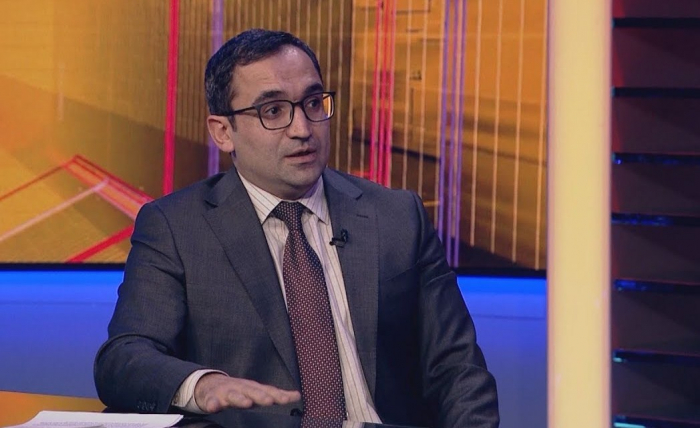The World Bank addresses a number of issues in its recent report on the realities, opportunities, and prospects of the Middle Corridor. The report strongly encourages to take joint steps in sea and rail transportation, general management, and coordination to make the project more attractive.
Economy expert Khalid Karimli agrees with some of the problems mentioned in the World Bank report on the MC in his interview to AzVision.az but deems it important to keep in mind that the project has only just started to take shape. He believes encountering certain challenges as the project develops is only natural.
‘Azerbaijan owns up to its shortcomings. The intensive focus on boosting the transmission capacity at the Alat seaport, upping the annual capacity from 15 to 25 million tons and investments as of 2023 are all a great illustration of that. The Middle Corridor runs through several countries and entails joint employment of several various multi-modal transport complexes. This highlights administrative facilitation and coordinated management issues. The stakeholders accept the situation and regularly take part in joint projects, particularly, the measures Azerbaijan and Central Asian countries have taken jointly are all aimed at solving these problems.’
- What problems does the railway infrastructure along the corridor have?
‘The railway is the second most convenient carrier for cargo after sea transport. It is especially crucial for the MC and North-South corridor. The completion of the Rasht-Astara railway line will naturally lead to a full-capacity operation of the North-South corridor. Azerbaijan was also hard at work to complete the Baku-Tbilisi-Kars in 2023 to launch the Middle Corridor. The BTK project has been completed fully in Azerbaijan and Türkiye, and by 90% in Georgia. Azerbaijan has also taken over helping friendly Georgia to finalize the project. It was even reflected in the 2023 budget. The traffic capacity will be increased to 5 million tons of cargo and one million passengers once the BTK railway becomes fully operational.
The second direction on the MC is the Zangazur corridor. Azerbaijan has invested heavily into building the railway line to Aghband, as we go forward in two separate directions. We are both investing into commissioning the BTK and working intensively and allocating resources to modify the Zangazur corridor in the Baku-Aghband-Nakhchivan direction. Operating these lines at full capacity will naturally lead to cutting both time and costs on the Middle Corridor.’
- What must we do and are we doing to secure efficiency of the MC compared to other transport-logistics projects?
‘The MC is a project that involves many countries. It envelops exporting goods from China and Central Asia to Europe through the Caucasus: to Türkiye and Europe through Azerbaijan and through the Black Sea in Georgia. This has grown in relevance particularly in the light of the sanctions imposed after the Russian-Ukrainian war. The ongoings in the Red Sea have also spotlighted the significance of alternative routes.
As the MC runs through many countries, it creates certain bureaucratic obstacles. Some of the complicating factors include the multi-modality of cargo traffic and transportation, such as land, railway, and sea transport all in a single corridor, and engagement of several institutions within one country. This requires building coordination and uniform tariff and simplified customs systems. The problem does not lie within a single country. The multitude of countries and variety of regimes within their territories complicate the matter at hand. The MC will naturally not become fully functional should the countries not deal with these issues, hog the blanket and prioritize their personal interests, and not simplify document flow and customs regimes.
That being said, Azerbaijan and Türkiye have coordinated efforts with Central Asia in recent years, working intensively on discussing bilaterally and multilaterally the potential problems that might arise in the MC, switching to a simplified customs system, centralizing management, applying digital solutions, and building uniform inspection and tariff systems.
No one is denying the complexity of these projects but proactive and systematic efforts by particularly Central Asia, Azerbaijan, Türkiye, and the Organization of Turkic States will lead to the solution of the issues raised by the World Bank. The WB report points out that the rapid solution of these issues will dramatically boost the transmission capacity of the MC. The problems have been identified and once they are resolved, the transit time on the Middle Corridor will be cut down by another two weeks, making the corridor one of the most cost-effective routes to deliver goods from China to Europe.
The heads of state and government, ministers of foreign affairs, of communications, and transport across the countries are hard at work. They are establishing commissions and are quite active. Solving the problems we mentioned above is beyond what a single country can manage. They are all worked on within mutual agreements. At the same time, the stakeholders have been taking consistent systematic steps, realizing the importance at stake, and introducing plans of putting the advantages of modern technologies to good use, which allows us to expect that it will be possible to solve all the bureaucratic obstacles and complicated issues that might arise in the Middle Corridor in a centralized and simplified fashion.
Sahil Isgandarov
More about:
















































